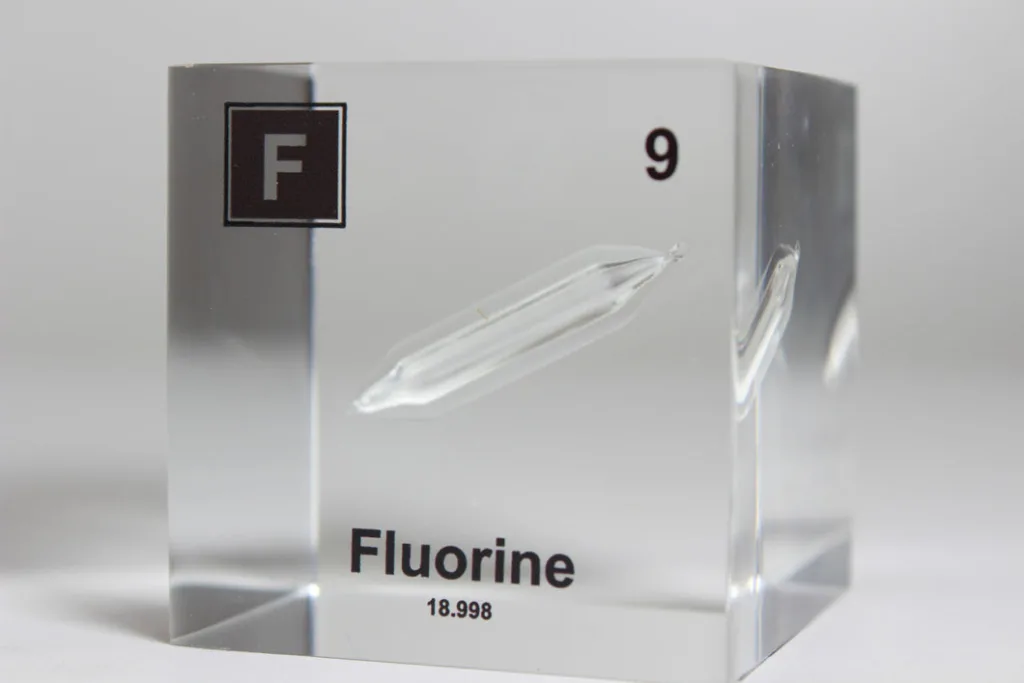Fluorine is a chemical element with the symbol F and atomic number 9. It is a highly reactive, non-metallic element that belongs to the halogen group in the periodic table. Fluorine is the most electronegative element, which means that it has a strong attraction for electrons.
Fluorine is not a metal, but a non-metal. Non-metals are elements that do not have the properties of metals, such as the ability to conduct electricity and heat, and they tend to be brittle and have low melting and boiling points. Fluorine is a gas at room temperature, and it is highly toxic and reactive. It is also the most reactive of all the halogens.
The electronic configuration of fluorine shows that it has 7 electrons in its outermost shell. This makes it highly reactive, as it only needs to gain one electron to complete its outer shell and become stable. Fluorine is known for its ability to form strong bonds with oter elements, and it is commonly used in the production of a variety of chemicals, including pharmaceuticals, refrigerants, and plastics.
One of the most common uses of fluorine is in the production of hydrofluoric acid, which is used in the production of aluminum, gasoline, and refrigerants. Fluorine is also used in the production of uranium, which is used in nuclear power plants. However, due to its highly reactive nature, fluorine must be handled with extreme care and caution.
Fluorine is not a metal, but a highly reactive non-metal that belongs to the halogen group in the periodic table. It is known for its ability to form strong bonds with other elements, and it is commonly used in the production of a variety of chemicals. Fluorine is highly toxic and reactive, and must be handled with extreme care and caution.
Is Fluorine a Gas or Metal?
Fluorine is a chemical element with the symbol F and atomic number 9. It is a highly reactive nonmetal that belongs to the halogen group of elements. Fluorine is not a metal, but rather a gas at room temperature and pressure. It is the lightest halogen and the most electronegative element, meaning it has a strong tendency to attract electrons towards itself.
Fluorine gas is a pale yellow gas that is highly toxic and corrosive. It has a pungent odor and can cause severe burns on contact with skin or eyes. Fluorine gas is not found in nature as a free element, but rather in compounds such as fluorite and fluorspar.
In addition to being a gas, fluorine can also exist in various oter forms such as liquid, solid, and plasma. Fluorine compounds are widely used in a variety of industries including the production of plastics, pharmaceuticals, and electronics.
Fluorine is not a metal but rather a highly reactive nonmetal gas that is toxic and corrosive. It is the most electronegative element and is widely used in various industries.

Why Fluorine is Classified as a Non-Metal
Fluorine is a non-metal due to its electronic configuration and characteristic properties. In its natural state, fluorine exists as a diatomic molecule, F2, which is highly reactive and corrosive. The electronic configuration of fluorine is 1s2 2s2 2p5, which means that it has 7 electrons in its outermost shell. This configuration gives fluorine a strong tendency to gain one electron to complete its outer shell, rather than lose seven to attain a noble gas configuration.
Fluorine’s electronegativity is the highest of all the elements, which means it has a strong attraction for electrons. This characteristic makes it highly reactive, preferring to form compounds with other elements rather than exist as a pure element. Fluorine is known to react with amost all the elements in the periodic table, except for the noble gases.
Another property of fluorine that makes it a non-metal is its physical state at room temperature. Fluorine is a gas at room temperature and does not have metallic luster or conductivity, which are typical of metals. Instead, it is a poor conductor of heat and electricity, and its physical properties resemble those of other non-metals, such as chlorine and oxygen.
Fluorine is a non-metal due to its electronic configuration, high electronegativity, and non-metallic physical properties. It is highly reactive and tends to form compounds with other elements rather than exist as a pure element.
Is Fluorine a Metal or Noble Gas?
Fluorine is not a metal nor a noble gas. It is actually a highly reactive nonmetallic element that belongs to the halogen family, along with chlorine, bromine, iodine, and astatine. Fluorine is the most electronegative element, meaning it has a strong attraction for electrons, and it readily forms compounds with other elements. It is a gas at room temperature and forms a diatomic molecule, F2. Fluorine is widely used in varous industries, such as in the production of aluminum, uranium enrichment, and fluorine-containing polymers. It is also an important element in medicine, as it is used in the creation of certain drugs and in the imaging of the body through positron emission tomography (PET) scans.
Conclusion
Fluorine is not a metal, but rather a member of the halogen family of non-metals. Its electronegativity is higher than any other element, making it extremely reactive and able to form compounds with nearly all other elements. At room temperature, fluorine exists as a faintly yellow gas with an irritating odor. Its atomic structure includes 7 electrons in its outermost shell, which contributes to its chemical properties. While not a metal, fluorine plays a crucial role in many industrial and biological applications, from producing acids and refrigerants to being used as a disinfectant and even in dental care. Its unique properties make it a valuable element in many fields of study, and its discovery and continued use have greatly benefitted science and technology.
